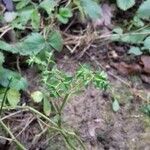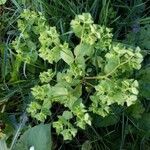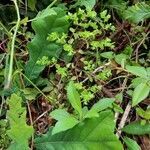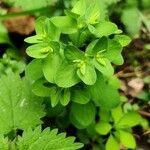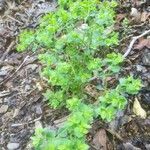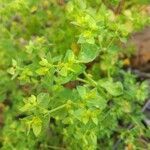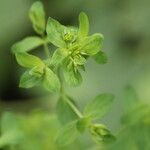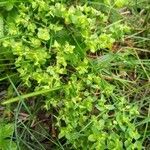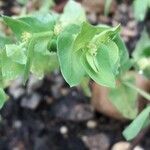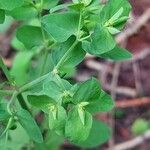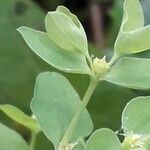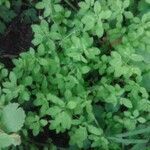Herbs, annual, with taproot. Stems erect, unbranched or branched, 5–30 cm, glabrous. Leaves: petiole 1–10 mm; blade obovate, oblong, or suborbiculate, 5–25 × 4–15 mm, base attenuate or cuneate, margins entire, apex obtuse, surfaces glabrous; venation pinnate, midvein prominent. Cyathial arrangement: terminal pleiochasial branches 3–5, usually 2–8 times 2-branched, 1st branching level rarely 3-furcate; pleiochasial bracts similar in shape to and slightly larger than distal leaves; dichasial bracts distinct, ovate to obovate, base obtuse, margins entire, apex obtuse, usually mucronate; axillary cymose branches 0–3. Cyathia: peduncle 0.4–1.1 mm. Involucre cupulate to slightly turbinate, 0.6–1.1 × 0.7–0.9 mm, glabrous; glands 4, elliptic, 0.2–0.3 × 0.5–0.6 mm; horns slightly convergent to divergent, 0.4–0.6 mm. Staminate flowers 10–15. Pistillate flowers: ovary glabrous; styles 0.1–0.2 mm, 2-fid. Capsules subglobose, 1.3–2 × 1.5–2.2 mm, slightly 3-lobed; cocci rounded, with 2 low longitudinal wings, smooth, glabrous; columella 1.1–1.3 mm. Seeds whitish or grayish, subovoid, 1–1.6 × 0.6–1 mm, abaxial faces regularly large-pitted (appearing almost alveolate), adaxial faces longitudinally sulcate; caruncle deciduous, conic, 0.2–0.5 × 0.2–0.7 mm.
Glabrous annual herb to 25 cm. high.. Leaves obovate, to 25 × 15 mm., base cuneate, apex rounded, margin entire; petiole of lower leaves to 1 cm. long, shorter above.. Cymes axillary and in terminal 3-branched umbels forking many times, with primary rays to 3.5 cm. long; bracts sessile, similar to the leaves but more ovate.. Cyathia on peduncles to 1.3 mm. long, 1 × 1 mm., with cup-shaped involucres; glands 4, transversely oblong, 0.5 mm. broad, with 2 horns to 0.8 mm. long; lobes rounded, minute, margins ciliate.. Male flowers: bracteoles linear, tips minutely ciliate; stamens 1 mm. long.. Female flower: styles 0.3 mm. long, joined at the base, spreading, bifid for 2/3.. Capsule exserted on a pedicel to 3 mm. long, deeply 3-lobed, with truncate base, 2 × 2 mm., with longitudinal fleshy ridges each side of the sutures.. Seeds oblong-ovoid, 1.5 × 1 mm., reddish brown becoming grey, with longitudinal rows of deep pits and a smooth white caruncle 0.3 mm. across.
Glabrous, erect or spreading annual. Stems 5-40 cm high, branched or not at base. Lvs alternate, exstipulate, entire, ovate, cuneate at base, subacute to obtuse, 3-20 mm long; petioles 2-5 mm long. Terminal umbel (2)-3-(4)-rayed, with often several to numerous axillary rays arising below; lvs subtending rays similar to stem lvs but usually subsessile; rays sometimes secondarily branched and then forming compound dichasia; lvs subtending ray-branches and cyathia ovate-triangular, sessile, truncate at base, often asymmetric. Glands elliptic-oblong; horns long, slender. Capsule smooth, shallowly grooved; keels with 2 slightly winged ridges. Seeds rounded, grey and brown, c. 1.5 mm long, with 2 long ventral pits and several small circular dorsal pits.
Annual, 1–3 dm, usually much branched; cauline lvs oblong-obovate or subrotund, usually petiolate, 1–2 cm, rounded to retuse at the summit, those subtending the umbel broadly ovate to obovate, those of the umbel smaller, ovate; rays of the umbel 3, repeatedly dichotomous; fr with 2 low longitudinal keels on each valve; seeds 1.5 mm, marked on the outer face with 4 rows of (2)3 or 4 large pits, on the inner face with 2 deep longitudinal furrows; 2n=16. Native of Eurasia, widely intr. in N. Amer. from N.B. to Alas., s. to Fla. and Calif., but seldom abundant. Summer. (Tithymalus p.; Galarhoeus p.)
Bisexual, erect, annual, glabrous herb, 0.1-0.4 m high, often single-stemmed. Leaves 6-18 x 4-12 mm, spreading, ovate to almost circular, green, tapering into short petiole. Cyathia in lax panicles, 2 mm in diam., green; glands 4, with 2 spreading horns on outer margins. Flowering time Apr.-Oct. Capsule 2 mm in diam., 3-angled with 2 ridges along each angle, glabrous, exserted for 2.5-3.0 mm.
Annual herb, up to 0.3 m high. Stems erect, branching near or at base; glabrous. Leaves alternate, subsessile or on slender petioles; blade obovate, suborbicular or ovate, 6-18 x 4-12 mm, apex obtuse, base tapering into petiole, margins entire. Flowers: in umbels; green; Oct.-Mar. Fruit a capsule, with fleshy ridges along angles. Seeds with rows of deep pits.
Erect annual herb, up to 300 mm tall. Leaves subsessile or on slender petioles, margin entire, up to 30 mm long, 15 mm broad. Capsule with fleshy ridges along angles. Seeds with rows of deep pits. Flowers green.
A fleshy annual herb. It grows 30 cm tall. It often has 2 branches from the base. It has milky sap. The leaves on the stem are alternate. The leaf blades are 1-2 cm long and up to 1 cm wide.
Cyathia on peduncles to 1.3 mm long, 1 × 1 mm with cup-shaped involucres; glands 4, 0.5 mm wide, transversely oblong with 2 horns to 0.8 mm long; lobes rounded, minute, margins ciliate.
Capsule exserted on a pedicel to 3 mm long, 2 × 2 mm, deeply 3-lobed with truncate base and with longitudinal fleshy ridges each side of the sutures.
Leaves with a petiole to 1 cm long, shorter above; lamina to 25 × 15 mm, obovate, rounded at the apex, cuneate at the base, entire at the margin.
Seeds 1.5 × 1 mm, oblong-ovoid with longitudinal rows of deep pits, reddish-brown becoming grey; caruncle 0.3 mm across, smooth, white.
Female flower: ovary glabrous; styles 0.3 mm long, joined at the base, spreading with deeply bifid apices.
Cymes axillary and in terminal 3-branched umbels forking many times, with primary rays to 3.5 cm long.
Male flowers: bracteoles linear, with minutely ciliate tips; stamens 1 mm long.
Bracts sessile, similar to the leaves but more ovate.
Annual herb to 25(35) cm high, glabrous.
